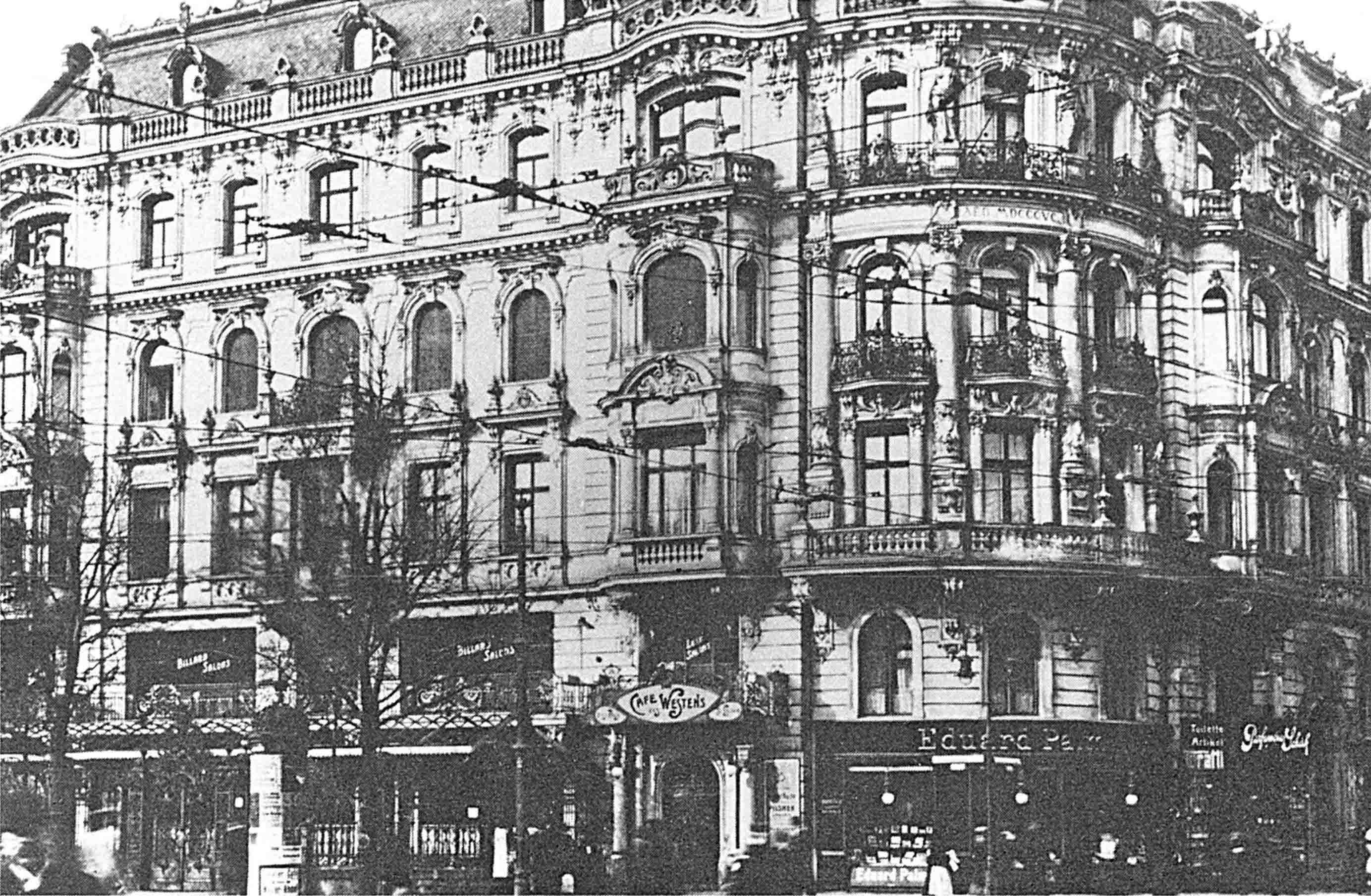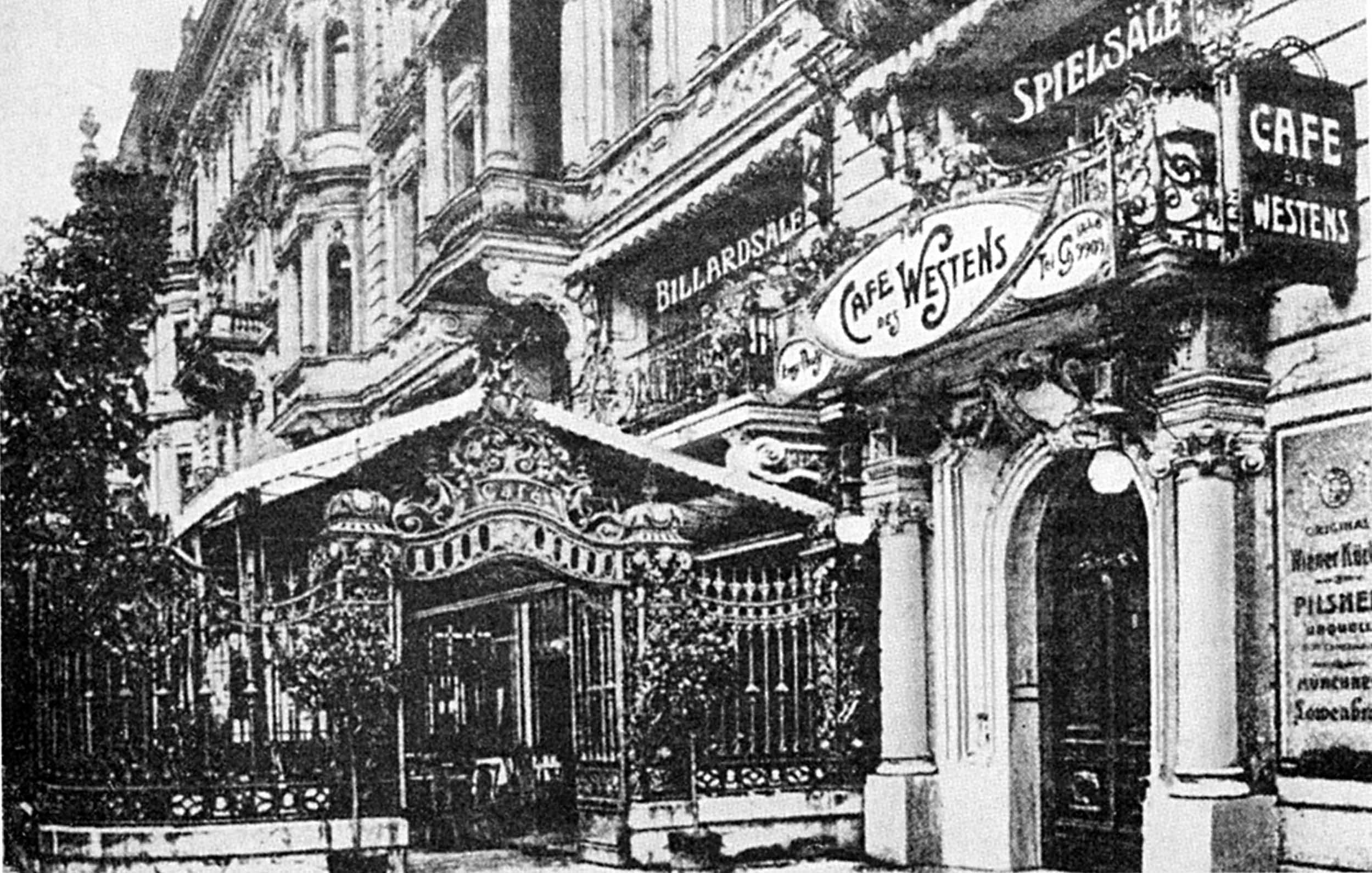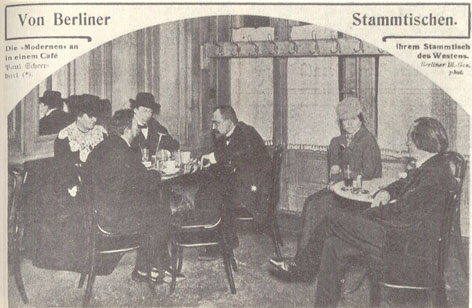Café des Westens
The Café of the West, also called Café megalomania, was a local Berlin artist, located from 1898 to 1915 at Kurfürstendamm 18/19, corner Joachimstalerstraße, today Kranzler Eck, was in Berlin -Charlottenburg.
Building and beginnings
The building, which housed the café of the West, was built in 1893-1895 as a representative residence of the master carpenter Christoph East. The architect Max Welsch designed the facade, richly furnished and with a mighty Attica in the form of an openwork balustrade with figures and acroteria.
1893 opened there on the ground floor the "little cafe ", which at the time was the first coffee house on Kurfürstendamm. Since the autumn of 1896 was formed by Maximilian Bern and Fritz steel a fixed Stammtisch. The surrounding residential buildings of the "New West" Berlin already some artists had rented studios, and instead of a pleasure to plunge into the bustle of the city, they met in the "Little Cafe ", which was in 1898 renamed to "Café of the West". As 1898 Rocco, " the cook of all cooks " the line took over, the feed was greater. Now came the artists from the center of Berlin, and in certain bourgeois circles it was cool to be able to tell from a visit to the crazy café. 1904 was the operator Ernst Pauly Café to the first floor into expand, then where, among other billiard tables were set up.
Meeting place of the literary
Quickly the local became the main meeting place of the Berlin artists and journalists. 1901 was here the idea to Ernst von Wolzogen cabaret artist Überbrettl, was to become the first German cabaret. The idea for the second Berlin cabaret sound and smoke, which was opened on stage at the Künstlerhaus on January 23, 1901 at Potsdamer Platz, was to Max Reinhardt, Frederick Kayssler and Martin Zickel at "Café Megalomania ". With these two theater -ups the development of the cabaret began in Germany. Although both closed after a relatively short time, however, there were enough followers. From Berlin to the cabaret spread throughout Germany.
The cafe took over the role of former bourgeois salons at the beginning of the 20th century. Among the artists were at the café soon two groups out, the so-called swimmer and non-swimmer pool. Anyone who has had a name, found himself on a master table of the painter Max Liebermann, writers and critics such as Alfred Kerr and Herbert Jhering included among these. At the table composers, led by Paul Lincke, Walter Kollo and Jean Gilbert were to be found.
The emerging bohemian joined the circle of artists The glasses on to Max Reinhardt and Christian Morgenstern. The idea of The Threepenny Opera was set in the café in the world. I am from head to toe love ... composed Friedrich Hollaender here.
Next wrong here Richard Strauss, Alfred Kerr, Maximilian Harden, Ludwig Fulda, Paul Lindau, Frank Wedekind and Carl Sternheim. The painter Emil Orlik, even a celebrity and regular frequenter, has drawn a lot of them in the café.
The "Café megalomania " for many artists was a kind home. The owner Ernst Pauly, who took over the cafe in 1904, came at his expense, because the partially indigent artists attracted the paying public. The "Café Megalomania " was also famous for the women, which could be seen here and latest chic demonstrated at the same time with its claim to emancipation.
In the last few years before the First World War, the "Café Megalomania " became the center of the literary movement of German Expressionism. Here met the avant-garde writers - Naturalism and Impressionism seemed overcome - and discussed with their colleagues: Else Lasker-Schüler and her husband Herwarth Walden, René Schickele, Roda Roda, Johannes Schlaf, Erich difficulty and John Henry Mackay, Peter Hille and Paul Scheerbart, Frank Wedekind, Artur Landsberger, Carl Sternheim and Leonhard Frank, Solomon Friedlander, John Hoexter and Jacob van Hoddis were here " home " - at the Cafe megalomania, no one came over, wanted to have a say and write in the new expressionist movement. Also important literary journals were founded: 1910 designed Herwarth Walden in the cafe his magazine Der Sturm, 1911 Franz Pfemfert the action.
Shortly before the First World War, the café became increasingly the headlines in the conservative press. The artistic circles in the café of the West were rabble from the "Café Megalomania ", they had the West Berlin turned into a swamp.
Perhaps it was these attacks that prompted the owner Ernst Pauly, 1913 in the new " Union Palace ", Kurfürstendamm 26, to move. Here he founded the new cafe in the West as a concert - cafe. At the old place, the café continued to exist until 1915. Artists, however, did not enter the new coffee shop around, it was the end of the café megalomania as a literary hangout. After the First World War, the Roman café at the Kaiser Wilhelm Memorial Church became the new literary center of Berlin.
1920 " Cabaret Megalomania " opened in the former premises of the cafes that: it had until 1922 inventory. 1932 opened the Café Kranzler a branch here. The building was destroyed in April 1945.
Since the 1970s until the demolition of the building in 1998, there was a cafe in the West inclined against the Kranzler -Eck Kurfürstendamm ( Architect: Werner Düttmann ).










